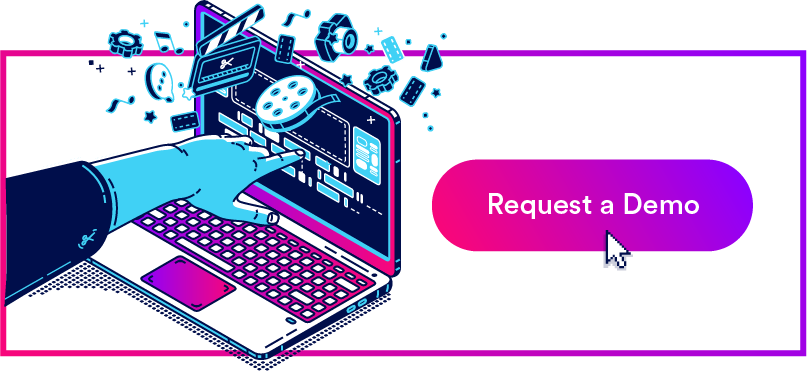- 1. Centralize Brand Collateral
- 2. Keep an Organized, Up-to-Date Asset Library
- 3. Store All of Your Product Images & Information Together
- 4. Make Sure Brand Assets Are in the Right Hands
- 5. Give Teams the Tools to Use & Re-Use Brand Collateral
- 6. Connect Brandfolder With Other Tools to Bolster Your Teams’ Workflows
- 7. Better Understand Your Customers & Refine Your Digital Strategy
- 8. Leverage Content Automation
- Brandfolder Retail Asset Management: Case Studies
- Demo Brandfolder for Free
Get branding tips and expert advice delivered straight to your inbox.
Retail businesses should consider digital asset management (DAM) software when:
- You have so many assets it's hard to remember what content you have and where it lives
- You have digital files scattered across several storage drives and can never find what you need
- You routinely battle with old, outdated, or unapproved content cluttering up your library
- You're constantly being hit with asset requests and wasting hours each week just sending content around to the people who need it
- You have multiple locations or different retailers who sell your products and you need to oversee how everybody uses your brand content
- You are constantly caught up in administrative tasks in repetitive work.
- You can't scale your retail business because the current DAM system is limited.
- You can’t make meta tags, so searching and finding exactly what you are looking for is not easy.
DAM systems are more than just advanced cloud storage drives: Digital asset management software eliminates organizational silos and facilitates unification so everybody — from the social media marketing teams who post your products online to the developers who build and design your eCommerce website — is working off of the same digital content and documentation. Not to mention, they also help teams avoid blunders like publishing expired promotional materials, old product imagery, or incorrect product information.
DAM systems are more than just advanced cloud storage drives: Digital asset management software eliminates organizational silos and facilitates unification so everybody — from the social media marketing teams who post your products online to the developers who build and design your eCommerce website — is working off of the same digital content and documentation. Not to mention, they also help teams avoid blunders like publishing expired promotional materials, old product imagery, or incorrect product information.
But that’s just the tip of the iceberg. In our post, we review seven benefits of digital asset management software for retail and eCommerce businesses. Throughout, we include examples of how you can leverage Brandfolder to connect all sectors of your business and operate more smoothly and efficiently.
Brandfolder is a versatile DAM solution that can be customized to a wide variety of retail businesses — so whether you have one or one hundred locations, we can help you manage your digital content and all of the teams that use it. Get in touch with our team to talk about what you’re looking for in a retail digital asset management system and walk through a free demo of Brandfolder.
Businesses of all sizes require a comprehensive approach to retail asset management. Otherwise, they face issues with asset waste, brand inconsistencies, lost time, and low marketing ROI.
Brandfolder is a versatile DAM solution that can be customized to various retail businesses. So whether you have one or one hundred locations, we can help you manage your digital content and all the teams that use it.
And that's just the tip of the iceberg. In our post, we review eight benefits of DAM software for retail and eCommerce businesses. Throughout, we include examples of how you can leverage Brandfolder for successful retail brand asset management.
Let’s get started!
1. Centralize Brand Collateral
First, Brandfolder lets you store all of your retail brand’s digital assets in one central location. If you manage assets for multiple retail brands, you can create multiple Brandfolders within your DAM software and keep track of each brand’s assets separately, in one system. This prevents the need for multiple storage drives and guarantees that all of the different teams that access and use your brand assets are using the right versions of files.
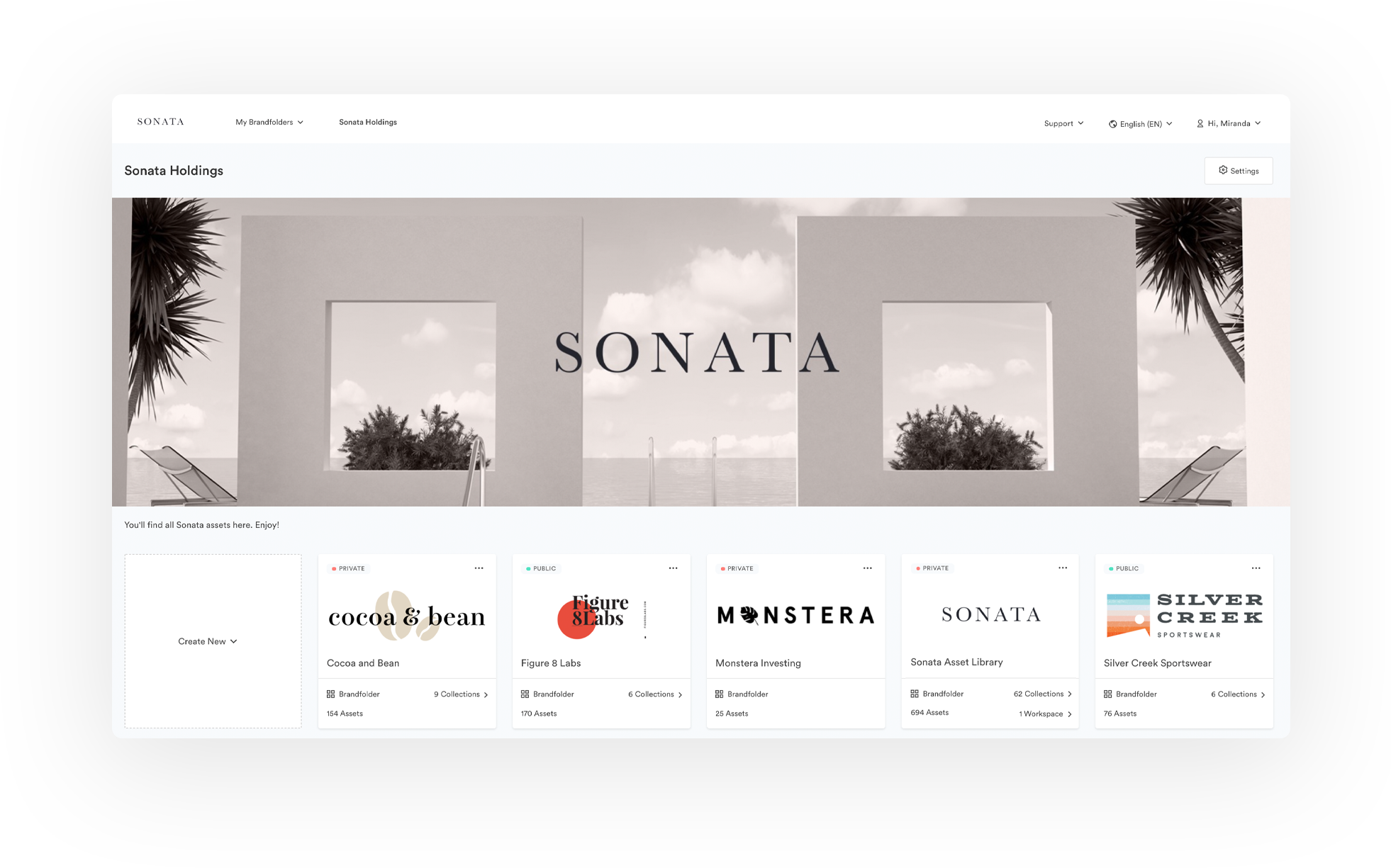
Within each Brandfolder, you can organize assets in Collections and Brand Portals.
Collections are groups of related assets. So for example, some retailers create separate Collections for each of the different product types they carry. Or, you can use Collections to store product packaging, sales materials, promotional videos, or other brand elements — we’ll even help you map out your asset library before moving over to Brandfolder to ensure it’s set up in the most logical, organized way.

Brand Portals are different from Collections as they serve to organize groups of relevant assets for specific end users. These are particularly helpful for large retail brands who have multiple locations, or brands that sell their products through other retailers. (For example, think of a global swimwear brand that sells suits, snorkels, and other swim gear in sporting goods stores.) Portals allow teams to consolidate all of the assets these end-users would need in one place; this improves the user experience because those users can easily find what they need, but it also restricts them from having access to your entire asset library.
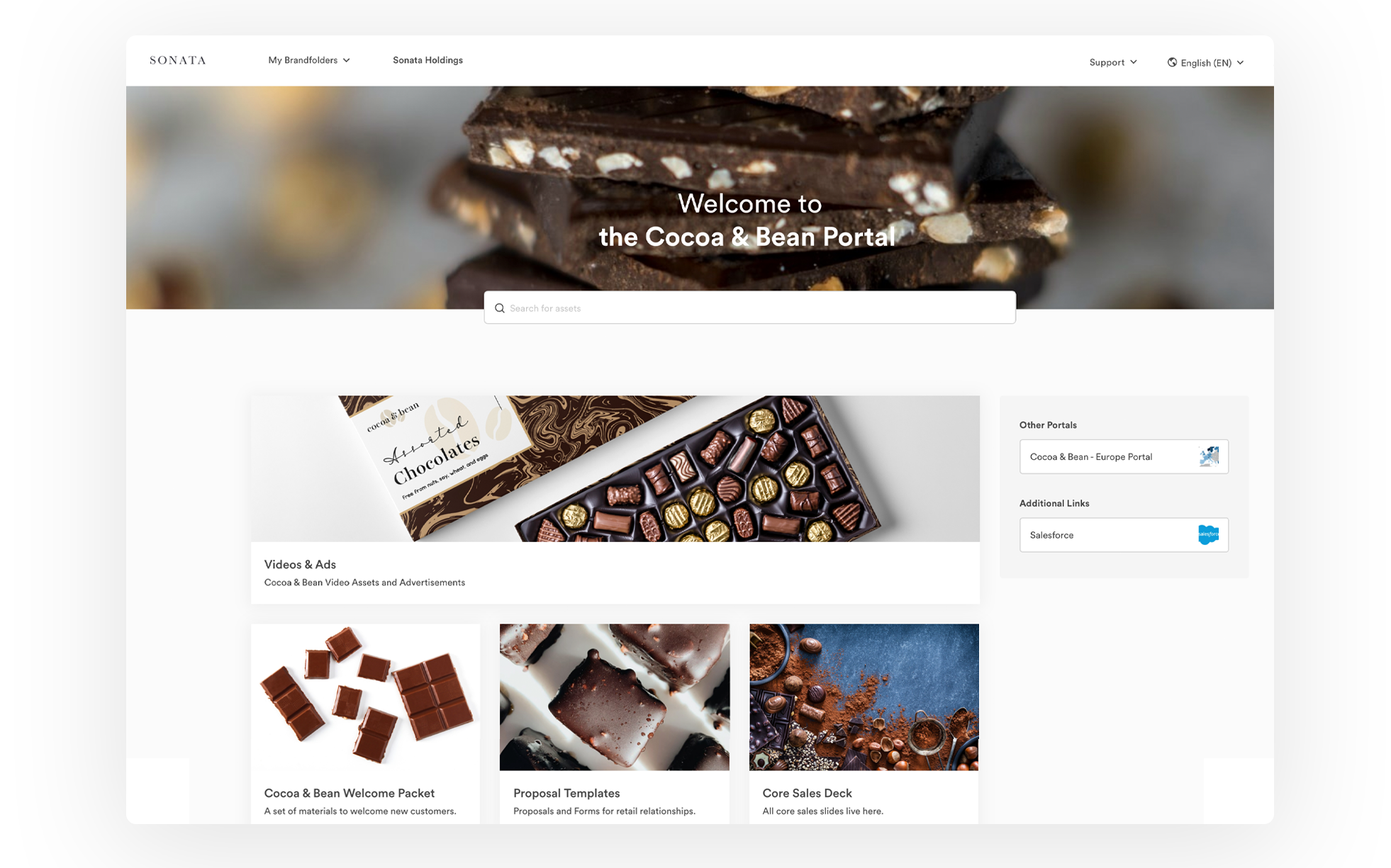
Pro Tip: We’ve also seen retail brands use Brand Portals to put together press kits. This is helpful if you’re preparing for a product launch or an upcoming event and you want to send all of the important marketing materials to the appropriate parties.
2. Keep an Organized, Up-to-Date Asset Library
Brandfolder also takes the hard work out of maintaining your asset library — with duplicate asset detection, expirations, and asset reviews, you don’t have to worry about periodic clean-ups or multiple versions of files piling up.
Duplicate asset detection does exactly what it sounds like: It detects duplicate assets during upload. If a dupe is detected, it’ll prompt the uploader to cancel the upload or merge the duplicate with the original file in an asset container. This prevents users from accidentally uploading the same asset twice, and allows teams to stack different variations of a single asset together. For example, we’ve seen retail teams use asset containers to store different versions of their logo, that way they can easily access those variations without creating clutter in the main library.

Asset expirations give you better control over the entire asset lifecycle by letting you set assets to expire, blocking others from downloading or using them. These are helpful for retailers and eCommerce brands that run seasonal campaigns, holiday sales, or other limited-time promotions because they can upload all of the material they need for those campaigns in Brandfolder and then set all of the materials to expire when the campaign is done. Those assets will still live in your Brandfolder (and can be un-expired if need be) but our system disables downloading on those assets so nobody uses old content.
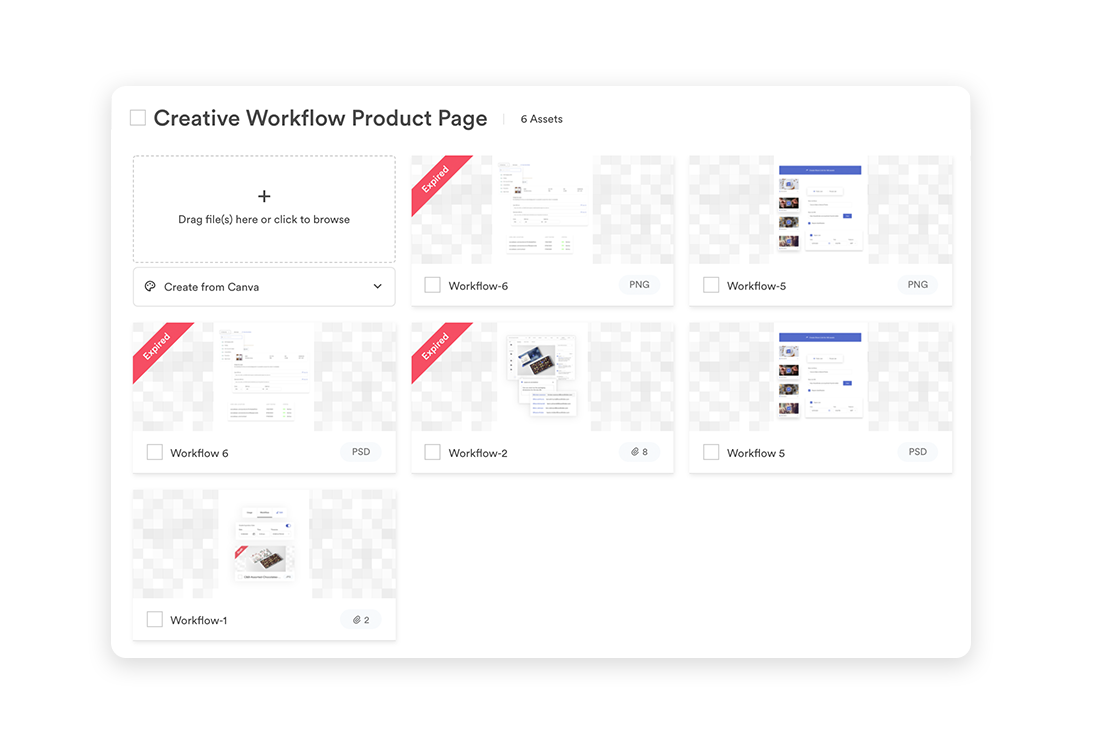
What’s even more convenient, though, is that Brandfolder lets you control:
- Who can upload new assets to your library
- Who can review and approve those new assets for other team members to access and use
You can even set real-time alerts for new asset reviews so content is never pending for too long.
This gives you total control over the content in your DAM and allows managers to delegate asset reviews to more than one team member so new content gets added to your DAM more efficiently.
3. Store All of Your Product Images & Information Together
Although a digital asset management platform is not a full-on replacement for a product information management (PIM) system, Brandfolder does give you ways to store product images and information together so all relevant documentation is available in your DAM for easy reference.
Going back to the asset containers we talked about earlier: You can use these containers to stack similar assets together — you can even stack different file types in one container for better organization. For example, you could include product images and other related graphics, primary and secondary packaging, brochures and sales materials, product catalogs, inventory spreadsheets, seller sheets, POS configuration documents, and more all in one asset container.
You can also use custom fields to track:
- Product attributes — SKU numbers & pricing information
- Specifications — Dimensions & weight
- Supplier information
- And other product metrics
You can access all of this information, along with all of the other asset metadata, in the Asset Overview.

You can also use the Asset Overview to store approved product description copy, digital rights information, “Dos & Don'ts” for posting on social media and other channel-specific information, and any other notes that would be relevant for distributors or stakeholders.
4. Make Sure Brand Assets Are in the Right Hands
Now that we’ve covered organization in Brandfolder, let’s talk about distributing those assets to the appropriate parties.
You can share digital assets with internal teams and other Brandfolder users with permissions, or you can send assets to people outside of Brandfolder (i.e., creative or marketing agencies, wholesalers, distributors, stakeholders, and any other partners) with custom share links.
- User permissions let you add users to singular assets or groups of assets - such as Brandfolders, Collections, Portals — and control exactly how they can interact with your content. These are convenient because they prevent the need to regularly respond to asset requests; once you add a user to a group of assets, they can access all existing files and any new content that’s added.
- Custom share links streamline the process of responding to asset requests when they do arise: Instead of sending zip drives via email, you can select the assets you want to share and generate a quick link. You can add or remove assets from custom share links at any time, set links to expire, disable downloading, watermark shared assets, require an email address to open assets, and more. All of our custom share links are trackable, too, so you can always see which assets are actively shared and with whom.
Best of all? We allow custom branding for asset portals, so regardless of how you share assets — whether via permissions or share link — all end users are directed to a clean portal with your brand colors, logo, and font to view your asset gallery. This gives you a more professional appearance when sharing digital content with people outside of your organization and other groups in the retail market.

5. Give Teams the Tools to Use & Re-Use Brand Collateral
Brandfolder is also built with features that empower teams to strategically use brand collateral for their unique projects, starting with the user-friendly search functionality.
Brandfolder’s search feature improves the search and discovery of assets because it uses artificial intelligence to, 1) scan the actual content of your assets, like colors, products, and background imagery, and 2) analyze your entire asset library, so it can pull all of the files that are relevant to your search query. No more digging through folders or racking your brain for exact file names.
As a result, you can locate the files you want with ease, and find new, related assets you may not have even known you had — this also prevents teams from re-using the same collateral over and over and gives all of your brand content visibility.
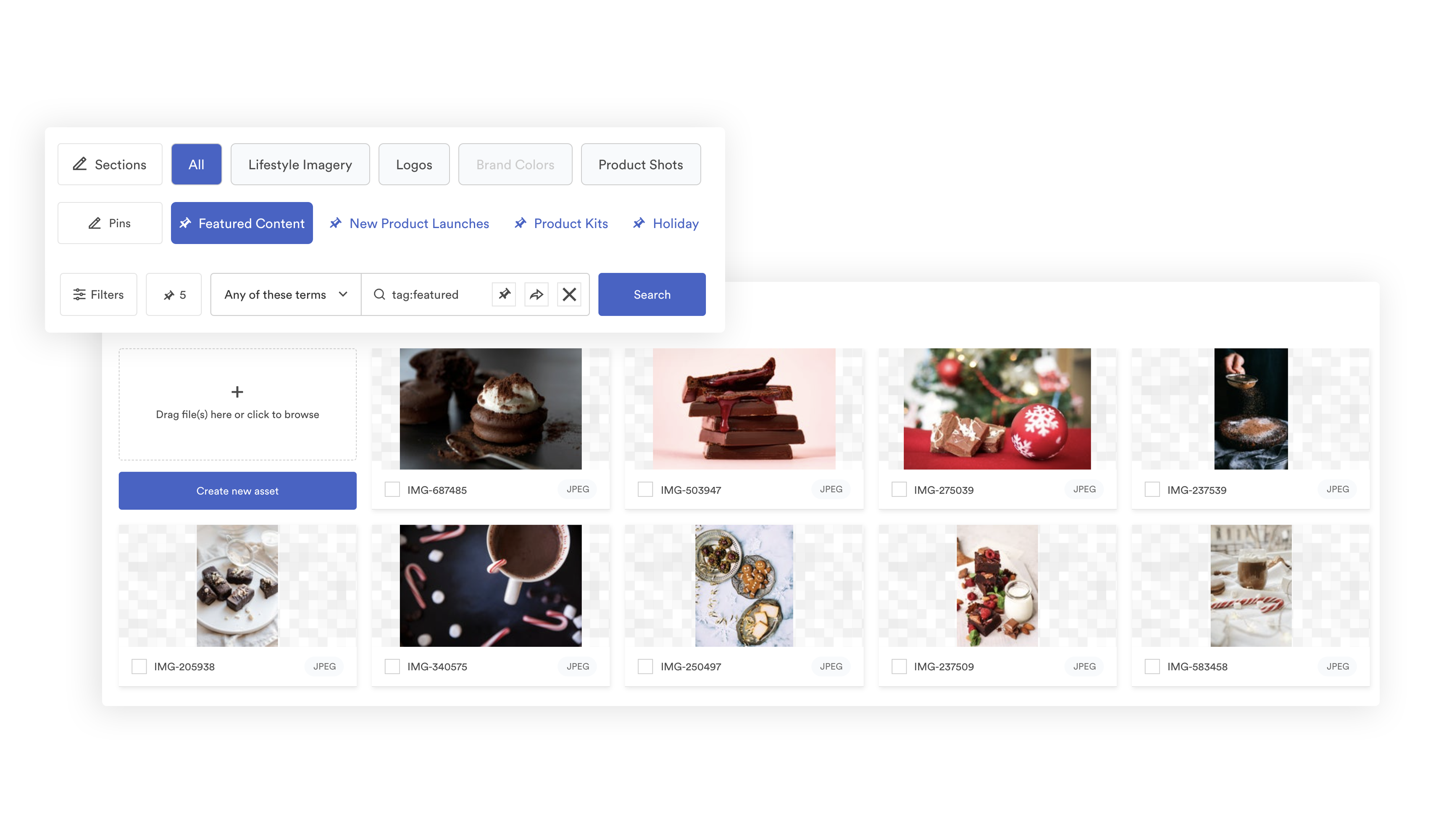
After you find what you need, you can use our convert & resize or custom & preset cropping features to optimize collateral for your specific use case.
- Convert & resize lets you modify an asset’s file type or resolution upon downloading.
- Custom & preset cropping lets you crop assets for different online mediums with a click. Brandfolder has preset crops for popular social media channels like Twitter and Facebook, but you can create custom presets for whatever sites you publish on most frequently. Many retail brands that have eCommerce sites create custom crops for different elements of their website.
You can also leverage Brandfolder’s templating tool to repurpose assets for new projects and enable new content creation. With our built-in templating feature, creatives can store pre-approved, on-brand templates and dictate exactly how other users can modify those templates. Then, teams with access to your branded templates can personalize them and push them out for their individual projects without having to ask a designer or manager to review and approve the updated collateral. This feature is especially useful for enterprise or global retailers because they can easily repurpose brand collateral for all of their different locations or branches.
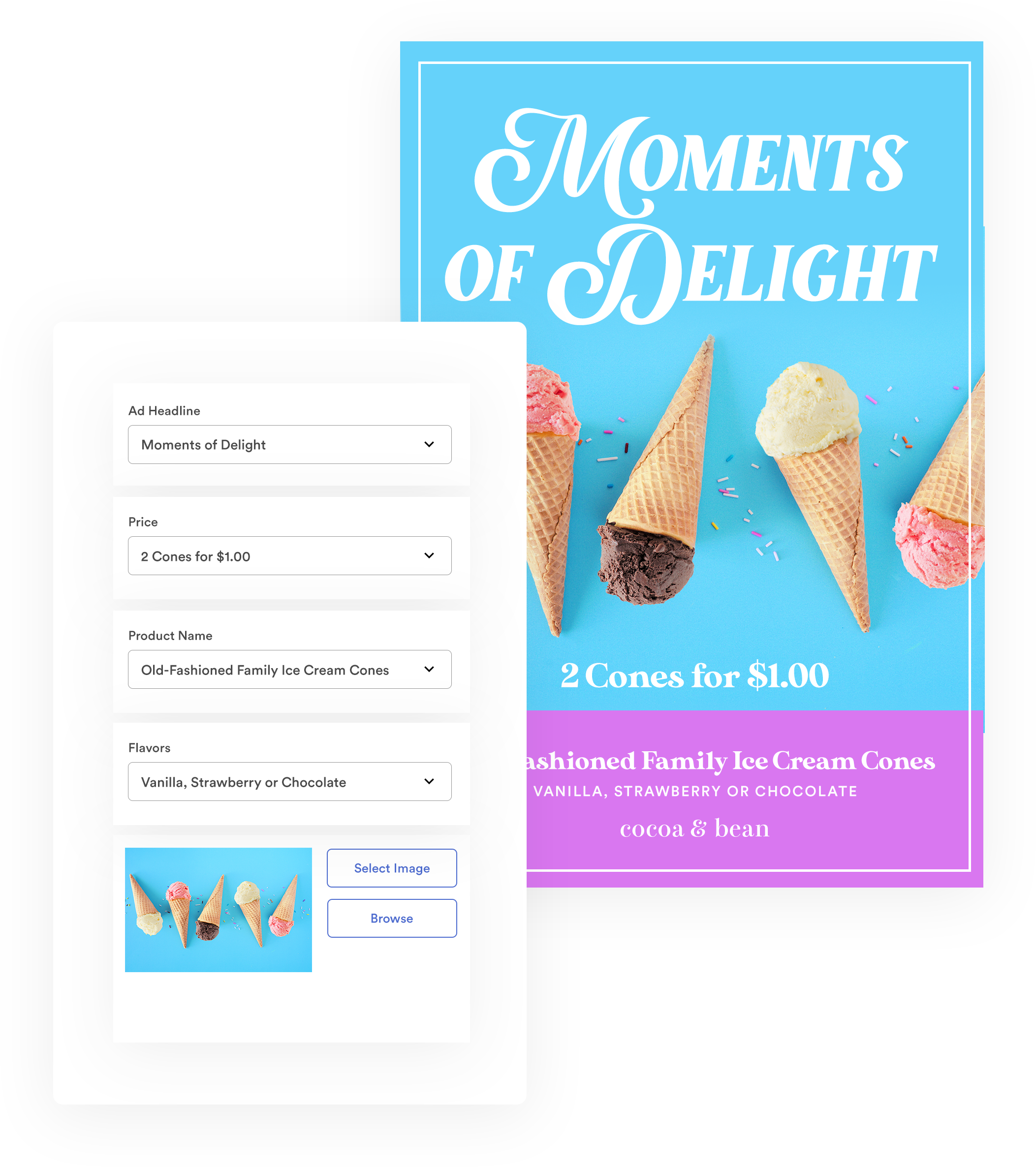
Brandfolder also lets teams store brand guidelines within the DAM platform to ensure that everybody has all of the information they need to stay on brand when using assets. Brandguide is an accessible portal for everybody you share your assets with, and you can include whatever information you deem relevant in this portal — we’ve seen teams include just the basics about brand tone and personality, while others dive deep into the specifics for posting different asset types on different channels. You can even add custom branding to these portals (like the share links) so everybody who needs to reference your brand guidelines is directed to a polished, professional-looking web page.
Between maintaining an updated asset library and keeping brand guidelines handy, you can greatly improve brand consistency and eliminate the burden of checking and re-checking every deliverable to confirm it’s good to go. This is especially important for big retail businesses that have a lot of locations and can’t realistically oversee every single consumer touchpoint.
You can also hone in on your brand image and make sure everybody’s using assets accurately by following our brand consistency checklist.
These “self-service” features allow all teams to work more independently, and they improve time to market for marketing campaigns and other digital efforts.
6. Connect Brandfolder With Other Tools to Bolster Your Teams’ Workflows
We designed Brandfolder to be highly customizable so it can support your existing workflows and processes. You can connect Brandfolder with your entire tech stack, out-of-the-box integrations, an open-source API, and use it as a hub to power all of your digital projects.
Some of our most helpful integrations for retail brands include:
- CRM systems & sales enablement software like Salesforce
- Content management systems (CMS) like Contentful
- Martech tools like Hootsuite
- Content creation software like Adobe’s Creative Cloud
- Project management software like SmartSheet
Brandfolder also has a built-in content delivery network (CDN) system so you can use your DAM as a single source of truth and publish assets directly from Brandfolder. In addition, it has web-to-print functionalities so you can quickly send assets to print without having to submit lengthy print requests.
- Most retail brands with eCommerce sites leverage Brandfolder’s CDN system to power their website content. This feature lets teams push assets directly from Brandfolder to their website, so it makes posting product images, sales information, and branding elements simple. Using Brandfolder to publish online is also beneficial for brand management: When assets are updated in Brandfolder, the changes automatically reflect anywhere the asset is embedded and website updates are instant.
- Retail brands who post a lot of in-store signage enjoy our web-to-print functionality because they can send high-quality digital files to the printer of their choice with a few clicks.
Read More: Benefits of Digital Asset Management Systems for eCommerce Brands
Not only is Brandfolder customizable, it’s also built to scale with your business. You can make modifications to your Brandfolder DAM at any time to better optimize the platform to work for your teams.
7. Better Understand Your Customers & Refine Your Digital Strategy
Brandfolder is also equipped with an internal reporting tool to help you get a closer look at your asset library and how your teams are using your content. All of the reporting features are completely customizable, so you can look at different data over different time frames.
For example, you can use these tools to look at:
- How many times an asset has been viewed, downloaded, or shared
- Top Performers (a.k.a. Your most frequently-used assets)
- Top Users, or the users who interact with your asset library the most
- Where assets are embedded online
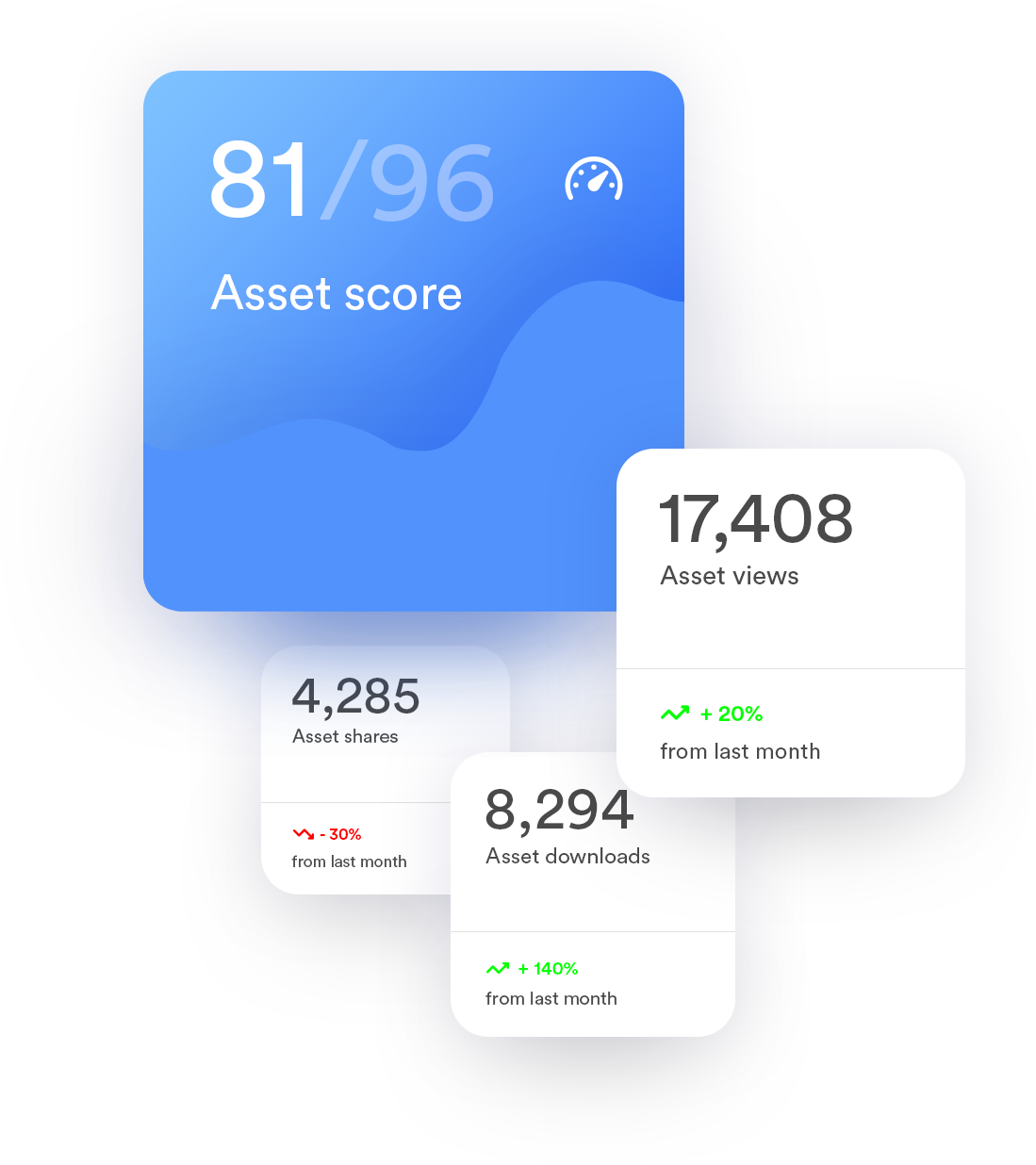
You can even look at what search terms users are typing into your Brandfolder and the results they generate, that way you can gauge the type of content your users need and what’s available to them.
Reporting tools are good for any manager who wants a better idea of how brand collateral is distributed and published, but they’re even more valuable for retailers that have in-house creative teams because they can use these insights to refine their creative strategy and continually improve. This helps everybody who uses brand collateral publish content that’ll resonate with their intended audience and drive results.
8. Leverage Content Automation
The main challenges that retail businesses face with content development include:
- Speed to market — lacking comprehensive tools makes developing, editing, and polishing marketing and brand content longer.
- Access to resources — the absence of resources often leads to time-consuming content development from scratch.
- Brand consistency — issues with retail asset management make it hard to provide consistency with brand materials.
Brandfolder Content Automation tackles the above pain points by centralizing all content and making templates available for every team member. You can set expiration dates on time-sensitive brand materials and adjust access permissions to eliminate inconsistencies and confusion, ultimately improving retail brand asset management.
Content Automation can also take your brand control to the next level with its innovative brand system. With it, you can codify the visual elements of your brand, such as logos, typography, and colors, and publish them across your templates. This makes large-scale brand updates a breeze!
When creating your templates, you can also control what users can edit regarding text and images. For instance, you can restrict users from swapping images from Brandfolder using a specific query or limit their ability to edit text without changing its color, bolding, or italicizing it.
An example would be a retail company launching a new product line and wanting to announce it with new promo flyers. With Content Automation, the company can allow its end-users, such as salespeople and retailers, to swap the product images on the new promo flyer while ensuring they only select from approved imagery.
How is this possible? The graphic designer can set up these specifications when building the template. This gives the retail company peace of mind that even if the template is editable, it can only be populated with approved and relevant brand assets.
You can take advantage of a variety of useful templates, including:
- Digital screen template — update and tweak digital screens anytime without a professional designer.
- Price tag templates — turn label artwork into a price tag template and allow all users with access to produce tags, in-office or professionally.
- Order form templates — create digital and print-ready branded order forms using a versatile order form template ready to be populated with new information.
- Shipping tag template — anyone in your company can generate a brand-new shipping tag without designing it from scratch.
- Invoice templates — create print-ready versions of your branded invoice template, populate the fields, and send them to the right recipients via email or platform. All changes to the template are instantly available to the entire network.
- Report templates — generate monthly, quarterly, and annual reports with a comprehensive template with data visualization features and brand colors. Distribute the reports to relevant parties quickly and easily.
- Event banner templates — design templates you can customize for each event and theme.
- Event invitation templates — take advantage of flexible templates that allow you to create branded invitations with the right features, content, colors, and fonts.
Other templates you can leverage are calendar templates, coupon templates, price list templates, label templates…the list goes on.
When it comes to retail asset management for SMBs and enterprises, these templates are significant time-savers. Besides maintaining impressive brand consistency, Brandfolder Content Automation can also:
- Streamline and optimize workflows — you’ll minimize the work of designers, agencies, and marketing leaders and allow sales and marketing specialists to create high-quality content. You’ll empower your employees to take more control over content creation and management. Meanwhile, the admin can oversee all access points to provide authorization and guarantee security.
- Scale asset production — when you need to create hundreds or thousands of content pieces, you don't have to involve your entire team and set up a time-consuming workflow. All you need to do is leverage templates and create content at the necessary scale.
- Improve speed to market — you can speed up asset creation, editing, and polishing. This allows your brand to react to market changes quickly and stay ahead of the competition.
Among other benefits, Brandfolder Content Automation features allow you to keep all your content centralized, updated, and readily available to everyone with an appropriate authorization level. This can optimize your marketing campaign tremendously. Instead of getting caught up in admin work, DAM for small businesses allows your marketing experts to focus on key revenue-generating tasks.
Brandfolder Retail Asset Management: Case Studies
Small businesses, enterprises and businesses in between are taking full advantage of Brandfolder’s retail asset management solutions. Here are the latest examples of retail-based organizations implementing Brandfolder in their operations successfully.
Bakers Delight
A successful bakery franchise in Australia faced challenges due to the changing marketing landscape. They sought a solution to meet their growing marketing needs across 540+ franchises.
Brandfolder Content Automation allowed Bakers Delight franchisees to produce, adjust, and leverage content without branding concerns or related downtime.
Immediately, the bakery saw improvements in local marketing strategies and saw a 60% decline in the volume of bespoke artwork requests. Soon, the company exceeded its monthly export goals by 30%.
Vermont Cider Co.
Vermont Cider Co., a company that produces and distributes gluten-free craft beverages, is managing seven dynamic, multinational brands that share a wide variety of branded marketing materials with users worldwide.
Vermont Cider Co.'s key challenge was keeping these materials in a centralized location. Without a comprehensive DAM system, the company's brand consistency was in danger, and many marketing materials went to waste.
After implementing Brandfolder, the company organized all its branded assets in one place, ensured all branded content was continuously updated, and customized sharing permissions to bring the right assets to the right users.
They can also tailor content in various languages according to their store locations.
Ultimately, Vermont Cider Company strengthened all seven brands while saving time and money on branding and marketing.
DAM Is a No-Brainer for Retail Teams
In the realm of digital asset management, retail teams grapple with numerous challenges, from centralizing all accessible assets and simplifying content access to addressing content wastage, downtime, and the prevalence of manual marketing tasks. Adopting the right strategy for retail asset management can expedite your sales and marketing processes, maintain brand consistency, and help you stay ahead in the competitive market.
A DAM system serves as a unified hub for storing various product assets, including images, videos, 360-degree spins, supplier logos, and other essential promotional materials that drive conversions and sales. It also functions as a storage space for marketing files such as catalog and POS artwork, campaign materials, graphics for digital ads, website banners, and more. Brandfolder offers numerous features that enable you to optimize asset management processes and ultimately enhance your company's overall performance.
Demo Brandfolder for Free
Curious to see how Brandfolder can work for your retail brand? We work with a variety of retail businesses, from small local businesses to large enterprise brands with hundreds of locations, and can tailor our digital asset management solution to support exactly what you need.
Get in touch with our customer experience team for a free consultation and demo of Brandfolder.

